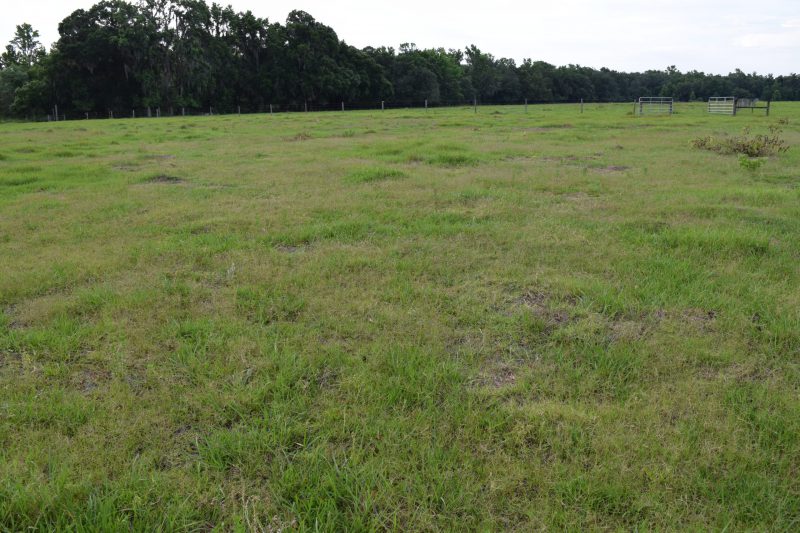
Spring transition is a key time for grazing management, fertilization, and weed control. Source: UF/IFAS File Photo
Marcelo Wallau, UF/IFAS Extension Forage Specialist, and Chris Prevatt, UF/IFAS Livestock & Forage Economist
As days grow longer and warmer, warm-season perennial pastures break dormancy and begin another period of growth. Fields are greening and the lush new growth is like candy for cattle. With that, comes a feeling of relief, because hay feeding is no longer needed. Especially in North Florida, this cool and rainy spring brings hopes of a great start for the summer season. Nevertheless, we have gotten many questions lately regarding poor pasture conditions and growth.
Although bahiagrass and bermudagrass pastures are greening up, actual growth is quite limited. Plants are still small with few leaves, and limited resources. Until we move into late May (given water availability) or June, actual forage production is not going to be very high. In the summer we can accumulate upwards of 50 to 80 lbs of dry matter per acre per day. In the spring you may not be accumulating more than 10 or 15 lbs. There are some exceptions, of course, like well fertilized limpograss or UF Riata bahiagrass. Other than those, it is very likely that pasture growth is still somewhat limited.
–
How does that affect cattle management?
The spring transition is extremely important for determining the productivity of your pasture for the rest of the season: if you abuse it now, then you will see a carryover effect well into the summer before pastures can recover and start growing well. For example, consider a dormant bahiagrass pasture where hay has been fed all winter, then all of the sudden there is new growth, so cows shift from eating hay and supplement to foraging (or scavenging) on this new growth. Each time the leaf blades are tall enough, they are grazed. This process, over and over, sets back the pasture quite significantly. In this scenario, the pasture will show no appreciable growth until conditions are favorable for faster growth, which animals cannot keep up with. All the while depleting the grass’s energy reserves. This weakens the pasture, delays peak productivity, and brings to light evidence of previous mismanagement. The famous “spring decline” is normally associated with pastures that have been abused, under fertilized, overgrazed and/or poorly kept. A weak plant will be more susceptible to endogenous pathogens, and we have plenty of latent fungal diseases awaiting an opportunity to flourish.
Alternatively, if animals are excluded from main pastures (kept on supplemental feed in a sacrifice area) until there is consistent and considerable growth, the entire system will be much better off for the remainder of the season. Why is that? By excluding cattle from the initial growth, you are basically “resting” that pasture before the first grazing, giving it a chance to break dormancy and grow well, before the cattle start harvesting the biomass. Remember, we want those leaves for the cows now, but more importantly, we need those leaves to make more forage for the next several months.
—
Other steps for ensuring a good pasture production this summer
–
1) Fertilize
Second to grazing management in this initial phase, comes fertilization and weed control. Visit your local extension office and get a soil test for your pastures, especially if you have not done that in several years. That will show the levels of main nutrients and pH of your soil, and indicate what fertilizer applications are needed. Different forage crops have different nutrient needs and recommended fertilization management practices. Sticking to our bahiagrass pasture from before, a spring shot of 60 – 100 lbs of nitrogen per acre can really get things going. A follow-up application of N in the early summer can boost bahiagrass productivity even further. In this case, a split application of 80 lbs of N per acre in the spring and 80 lbs early summer is recommended. Phosphorus and potassium will depend on soil levels and should be decided based on analysis results.
–
2) Control Weeds
Weed control should come after grazing management and soil fertility have been addressed. If we just control weeds, but don’t give our pastures a chance to grow, we are just encouraging more weeds to come and further decline. Those weeds more than likely started in the first place because the pasture was weak and in need of rest and nutrients. Once those bases are covered, then we can think on a more aggressive weed control. There are many herbicide options depending on pasture type and weed species. In most cases, it pays to control weeds early in the season, while they are still small. Herbicides with residual activity can be more expensive, but are certainly worth considering because they have the ability to suppress new weed growth for extended periods, reducing the need for more frequent applications. Selecting and implementing the most efficient weed management plan can be complicated, consult with your local extension agent for assistance.
–
More information is available in the following publications:
Getting the Most out of Bahiagrass Fertilization
UF/IFAS Standardized Fertilization Recommendations for Agronomic Crops
Weed Management in Pastures and Rangeland
- 2025 Southeastern Hay Contest Sets New Records - October 24, 2025
- 2025 Cool-Season Forage Official UF/IFAS Variety Trial Results - September 5, 2025
- Revisiting Crop–Livestock Integration in the Southeastern United States - September 5, 2025

